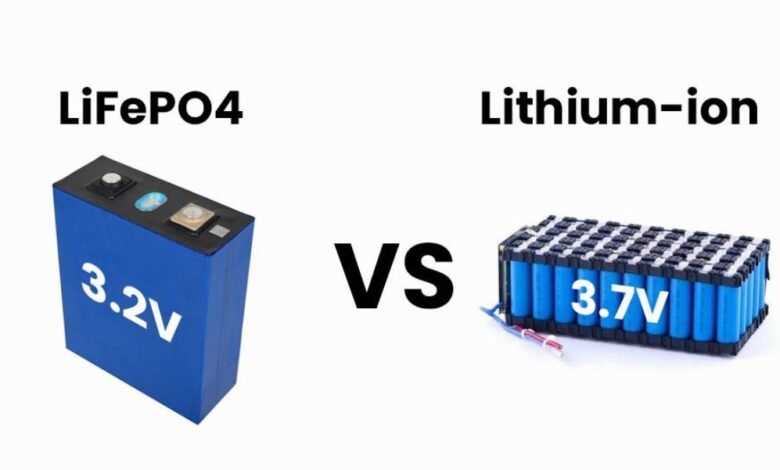LiFePO4 Battery vs Lithium-Ion Battery: A Comprehensive Comparison

Energy storage is one of the most important innovations of the modern era. From smartphones to electric vehicles to renewable energy integration, batteries power nearly every aspect of daily life. Among the many technologies available today, LiFePO4 battery systems and conventional lithium-ion batteries are two of the most widely used solutions.
Both technologies fall under the broader category of rechargeable lithium-based batteries, but they differ significantly in chemistry, performance, safety, cost, and applications. This in-depth comparison explores the strengths and limitations of each, helping consumers, businesses, and renewable energy adopters choose the right storage technology.
What Are Lithium-Based Batteries?
Lithium batteries work by shuttling lithium ions between a cathode and an anode through an electrolyte. When charging, ions move into the anode; when discharging, they move back toward the cathode, generating electricity in the process.
While “lithium-ion” is often used as a blanket term, several chemistries exist within this family:
- Lithium Cobalt Oxide (LCO): Common in smartphones and laptops.
- Lithium Manganese Oxide (LMO): Used in power tools and medical equipment.
- Lithium Nickel Manganese Cobalt Oxide (NMC): Popular in electric vehicles.
- Lithium Nickel Cobalt Aluminium Oxide (NCA): High energy density, used in Tesla cars.
- Lithium Iron Phosphate (LiFePO4): Safe, durable, increasingly popular for renewable energy.
This article will focus on comparing LiFePO4 with mainstream lithium-ion chemistries (LCO, NMC, NCA).
The Basics of LiFePO4 Battery Chemistry
The LiFePO4 (Lithium Iron Phosphate) battery uses iron phosphate as the cathode material and graphite carbon as the anode. Its structure provides strong thermal and chemical stability. This makes it inherently safer than other lithium-ion chemistries, which rely on cobalt and nickel oxides.
Key characteristics include:
- Stable chemistry with reduced risk of overheating or combustion.
- Long cycle life, often exceeding 4000–6000 charge cycles.
- Lower energy density compared to nickel-rich lithium batteries.
- Wide operating temperature range, suitable for hot or cold climates.
Lithium-Ion Battery Chemistry Overview
Conventional lithium-ion batteries typically use cobalt or nickel oxides in their cathodes. These materials provide higher energy density, which means the batteries can store more power in a smaller package. However, they are more reactive and prone to thermal runaway under stress.
Key characteristics include:
- High energy density, making them lightweight and compact.
- Shorter lifespan, usually 500–1500 cycles, depending on use.
- Higher risk of overheating, requiring advanced battery management systems.
- Widespread use in consumer electronics and electric mobility.
Performance Comparison: LiFePO4 vs Lithium-Ion
1. Energy Density
- Lithium-ion: 150–250 Wh/kg
- LiFePO4: 90–160 Wh/kg
Lithium-ion clearly outperforms LiFePO4 in energy density, which is why it dominates smartphones, laptops, and EVs where size and weight matter.
2. Lifespan
- Lithium-ion: 500–1500 cycles
- LiFePO4: 4000–6000 cycles
Here, LiFePO4 is superior. Its long cycle life makes it ideal for stationary storage and long-term renewable integration.
3. Safety
- Lithium-ion: More vulnerable to thermal runaway, fire, or explosion if damaged.
- LiFePO4: Stable and non-toxic, with strong resistance to overheating.
This safety advantage is why LiFePO4 is gaining popularity in residential and commercial solar applications.
4. Temperature Tolerance
- Lithium-ion: Sensitive to extreme temperatures.
- LiFePO4: Performs well in a wide range, from -20°C to 60°C.
5. Maintenance
- Lithium-ion: Requires careful charging cycles and management systems.
- LiFePO4: Easier to maintain and less prone to degradation.
Applications of LiFePO4 and Lithium-Ion Batteries
LiFePO4 Applications
- Renewable Energy Storage: Common in off-grid and hybrid solar systems.
- Electric Buses & Utility Vehicles: Where safety and longevity outweigh compactness.
- Marine Applications: Resistance to heat and vibration makes it reliable.
- Home Energy Storage Systems: Paired with inverters for daily energy management.
Lithium-Ion Applications
- Consumer Electronics: Smartphones, laptops, tablets, wearables.
- Electric Cars: Compact design with high energy density.
- Drones & Power Tools: Require lightweight, powerful batteries.
- Medical Devices: Where size efficiency is critical.
Cost Comparison
- Lithium-ion: Typically cheaper upfront due to widespread mass production.
- LiFePO4: Higher upfront cost but more cost-effective over time because of long lifespan.
For example, while a lithium-ion pack might cost 20–30% less initially, a LiFePO4 battery can last 3–5 times longer, leading to a lower total cost of ownership.
Environmental Impact
- Lithium-ion: Mining cobalt and nickel can have significant environmental and ethical issues, particularly linked to supply chains in developing countries.
- LiFePO4: Made from iron and phosphate, both of which are abundant and non-toxic. This makes recycling easier and less hazardous.
As sustainability becomes a top priority, many organisations prefer LiFePO4 for its reduced environmental footprint.
LiFePO4 in Solar Energy Systems
The rise of renewable energy has boosted the demand for safe, efficient, and long-lasting storage. In this sector, LiFePO4 dominates because of:
- High cycle life, ideal for daily charging from solar panels.
- Stable discharge curve, ensuring a consistent power supply.
- Minimal degradation, even after years of cycling.
Pairing LiFePO4 storage with a solar battery cabinet enhances energy independence, reliability, and sustainability.
Pros and Cons of Each Technology
LiFePO4 Battery
Pros: Long lifespan, safety, stable performance, and environmentally friendly.
Cons: Lower energy density, higher upfront cost, bulkier size.
Lithium-Ion Battery
Pros: Compact, lightweight, high energy density, affordable upfront.
Cons: Shorter lifespan, higher safety risks, and environmental concerns.
Which One Should You Choose?
The choice depends largely on the application:
- Choose Lithium-Ion if you need compact, lightweight power for laptops, drones, or electric cars where space efficiency matters.
- Choose LiFePO4 if you want safety, longevity, and reliability for solar systems, home energy storage, or heavy-duty industrial use.
Future Outlook
Battery technology continues to evolve. While lithium-ion remains dominant in portable electronics, LiFePO4 is rapidly expanding in renewable energy and grid-scale storage. As global demand for clean power grows, safer and more sustainable options like LiFePO4 are expected to take a larger market share.
Manufacturers are also improving LiFePO4’s energy density while reducing costs, which could make it competitive even in sectors currently dominated by traditional lithium-ion chemistries.
To Conclude
The comparison between LiFePO4 and lithium-ion batteries highlights the trade-offs between energy density and safety, cost, and longevity. While lithium-ion remains ideal for portable electronics and electric mobility, LiFePO4 is emerging as the superior choice for renewable energy integration, heavy-duty applications, and long-term storage.
For households or businesses considering solar adoption, investing in a LiFePO4-based energy storage system ensures decades of reliable performance with minimal safety risks. Meanwhile, lithium-ion will continue to drive innovation in compact technologies, proving that both have an essential role in the clean energy revolution.




